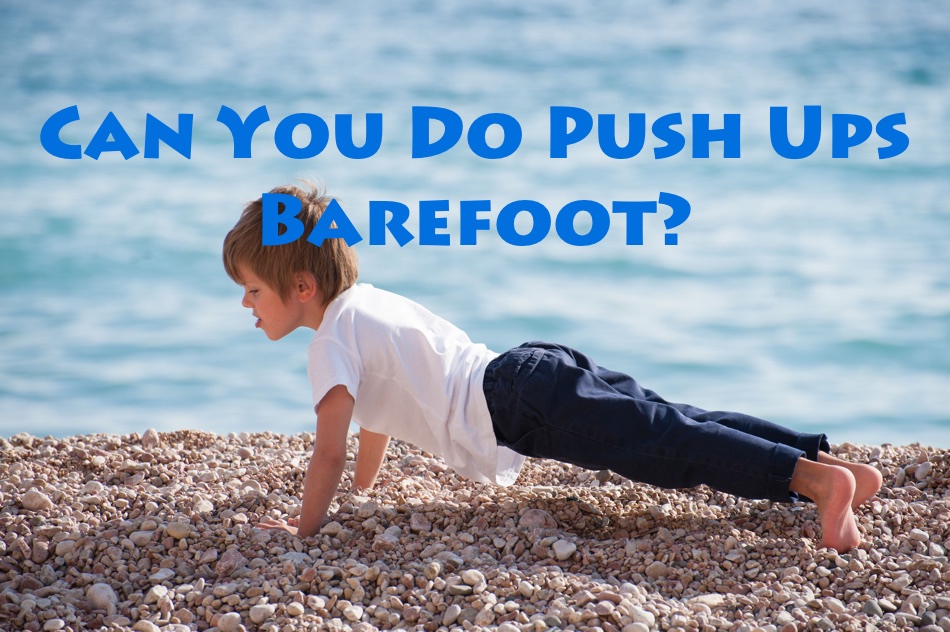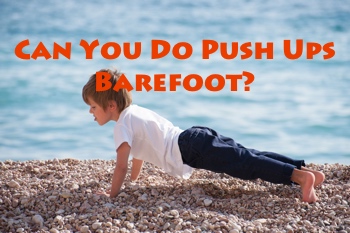
Yes You Can Do Push Ups Barefoot
Can You Do Push Ups Barefoot?
Table of Contents
Push-ups are an excellent full body exercise that I like a lot and have enormous benefits for the entire body. They have become a staple as part of many training circuits because of their effectiveness and the wide number of variations you have to choose from.
Can you do push-ups without shoes? You can do push-ups without shoes yes. Your feet will need to get used to the exercise in the beginning. In addition pay attention to where you do your push-ups. Most surfaces at the gym or home will be fine. As long as you can walk on it safely barefoot and your hands are ok you are good to go.
Even the Special forces around the world use them as one of their core movements. Maybe like some you do a number of push-ups every morning when you get up, you may not always have the will or the time to put your shoes one. Doing your push-ups barefoot may be the quickest most convenient thing to do.
Let us step through all you will need to know to be able to do push-ups barefoot.
What is a Push-Up
The push- up or press up as it is also known, is a core body exercise that begins with you supporting your entire body on your outstretched arms palms facing down on the ground. From this position you lower your entire body bending your elbows and with your legs remaining straight and in line with you back till your chest touches the ground and then back up again. All the while keeping your abdominals tight, glutes tight and legs straight pivoting from your toes.
They are one of my favourite exercises because you can do them anywhere with great effect giving you enormous benefit. You get to work your biceps triceps, abs, glutes and shoulders.
There are many ways of doing push-ups to choose from, let us have a look at the top 5 push-up variations, these include:
- Standard push-ups
- Close hand push-ups
- Wide Arm push-ups
- Cross Legged push-ups
- Diamond push-ups
There are many more to choose from, but these cover all most of us will need or probably do barefoot.
How To Do A Push-Up Barefoot
The initial set up very similar to the set up for the plank. See my article on the barefoot plank here. There are some key point that you will need to get set up correctly
1) Top Set-Up – Get your elbows and hands slightly wider than your shoulders. Keep the weight of your upper body evenly distributed over your upper arms in line with your elbows. Your hands and fingers should preferably be pointed forward. This can change if you are a beginner and it a bit uncomfortable to start with. Ensure that your elbows are not locked out to full extension.
2) Shoulder and Rib Cage Set-Up – Squeeze your shoulders into the ribcage, this will help make sure that your arms are in position and your core muscles are fully engaged. Next, tighten your lat muscles to keep your shoulders in position and in line with your torso.
3) Back Set-Up – Ensure your whole back is lengthened in both directions stable. Keep your head in the neutral position looking down at the floor. A good rule of thumb is to ensure you can trace a straight line from the top of your shoulders to your hips and then ankles. Keep your lumbar spine in a neutral position. Do not overextend or arch as you set up. Keep your back lumbar spine long throughout the movement.
4) Abdominals and Glute Set-Up – Actively engage your abdominal muscles with a firm contraction and hold. Tighten and contract your glute muscles at the same time too. While you are doing this, make sure you don’t hold your breath (more on this later).
5) Feet Set-Up – The best position is to balance on the balls of your feet and toes like the set up for the plank, drive back into the ground by tightening your quad muscles, this will keep your knees in position. Push your feet back into the ground, which will drive your heels backwards in combination with the knee extension. Depending on the type of push-up you are doing your feet should be hip-width to avoid stress on your lower back.
6) Breathing Set-Up – once you have the basic movement dialled in this is the next most important thing to do to ensure you can get the volume of reps before full exhaustion. Whatever you do don’t hold your breath during the movement. Simple inhale as you descend, and exhale on the return to the top position. Repeat this for each rep throughout the movement.
Top Tips
- Keep your core tight – and don’t overextend or arch your back during the movement.
- Keep your elbow close to your ribcage tucked in during the movement.
- Keep the full range of motion for each rep letting your chest tough the floor, so you get improve faster. One good pushup is better than five half push-ups, your body will quicked adapt.
Barefoot Push-Up Variations
Let’s take a closer looker at some of the push-up types we mentioned earlier:
The set up will be roughly the same as we just described for all the push-ups below. the only difference will be hand and foot positioning
1. Standard Push-ups – This is the most common push most people do. The set up is as above, beginning in the top of the plank position. Remember not to lock out your arms at the top of the movement. Aim to do about 5-10 reps per set of this variation. This is the perfect starting variation for the beginner.
2. Close Hand Push-Ups –This movement works the centre of the pectoral and triceps muscles more. Begin at the top of the plank position. Lower your chest to the ground, Push back up tucking your elbows in. Repeat movement.
3. Wide Arm Push-ups – This variation is a little more difficult. It works the shoulders and the chest. Begin at the top of the plank position. Lower your chest to the ground, Push back up tucking your elbows in. Repeat movement.
4. Crossed Legged Push-ups – Once again, put yourself into the top plank position as we discussed above. In this case cross one of your legs over the other at the ankles to add some variety and difficulty. Lower your chest to the ground once again, push up and repeat.
4. Diamond Push-ups – These are a lot more difficult to do. Set yourself up into the top plank position as we discussed above. This time place your hands together, fingers pointing forward with thumbs and for fingers touching each other forming a diamond shape. lower your chest to the ground once again, push up and repeat.
Five Other Exercises You Can Do Barefoot
Let’s have a look at the other exercises you can do with no shoes
1. Barefoot Kettlebell Swings
Barefoot kettlebell swings or KBS is an explosive full body work out. Doing this movement barefoot gives your body an excellent feel and grip of the floor. Keeping good form and driving from the heels as you execute the sequence. The movement aid in building the core and adding to the development of core strength in the hips especially.
2. Barefoot Planks
Barefoot planks are also good for building up foot strength. I have a written about Barefoot planks here. They are really good for building your core muscles too
3. Barefoot Deadlifts
Deadlifting is one of the best essential exercises you can perform. Doing it without shoes mean you will have t be careful not to drop anything on your feet. Some gyms need you to wear shoes some don’t so bear that in mind. Barefoot deadlifting let you feel the ground better and eliminates the forward tilt you get from wearing weightlifting shoes. Read more about Barefoot deadlifts here.
4. Barefoot Air Squats
Barefoot Air squats variation require you to activate the core and hip complex. The basic movement mimics you sitting on a chair in a controlled manner. You shift your weight backwards with an upright torso as you descend. It is common knowledge and generally agreed that squatting barefoot strengthens your feet and helps you to avoid hip issues later on in life.
5. Barefoot Walking Lunges
Doing lunges barefoot is great for strengthening the feet. Walking lunges, are a great leg conditioner Do them without weights if you are new to barefoot workouts. During the lunge, use your entire foot to grip the floor as best you can. Lunging barefoot will help you experience a more grounded feel. The expanding of your feet and spreading of your toes gives you a brilliant base to get you going.
Wrap-up
Doing the plank without any shoes is an excellent exercise to have in your training arsenal. The exercise helps you to build your core muscles which are essential to optimal health and fitness.
It forms a mini-complex of exercises that can be done barefoot in whichever definition you choose. That may be with no shoes, with socks or minimalist shoes.
We looked at the other exercises you can do barefoot:
- Kettlebell Swings
- Planks
- Deadlift
- Air Squats
- Walking lunges
The technique will come with practice, as soon as that is sorted, you will have a much stronger base for all the other exercises we have looked at in this article. Increased foot strength and flexibility is a benefit of doing the push-ups with no shoes; this strength will serve you well for other foundational movements as well. Have a read of my article on Drills for barefoot strength here
